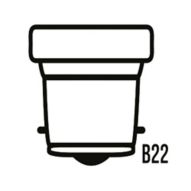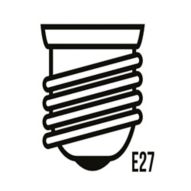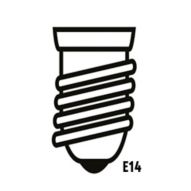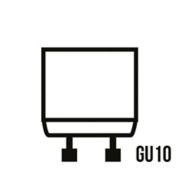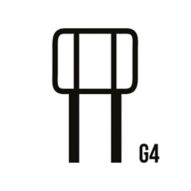Light bulb buying guide
Light bulb buying guide
Introduction
There are so many light bulbs available, with different codes and numbers on the packaging, that it can get very confusing. But choosing the right bulb is vital. Not only does it need to fit the light fixture, but it can make a significant difference to the ambience and mood of a room too. So, it’s worth taking a bit of time to understand the choices.
This light bulb buying guide tells you everything you need to know about buying light bulbs. We cover all the practical stuff, such as light bulb types, fittings, sizes, shapes and energy efficiency. And we include information to help you choose the best light bulb for a room, with tips about light bulb brightness, colours and other things to consider before buying.
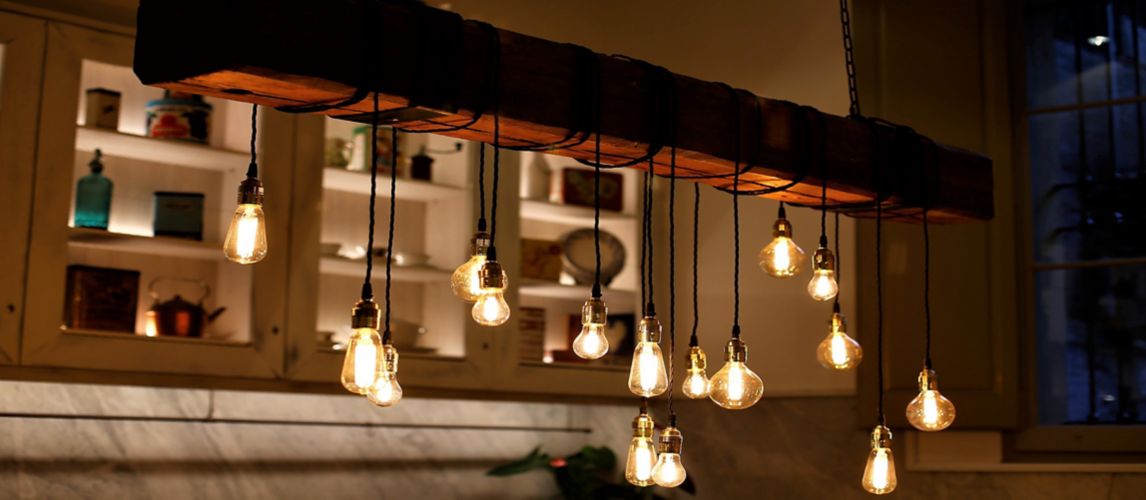
Light Bulb Types: Technologies
There are four different light bulb technology types:
- LED bulbs
- CFL bulbs
- Halogen bulbs
- Smart bulbs
Each light bulb type works using different technology, and they all have their pros and cons, which we will cover in the following sections.
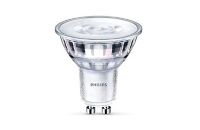
What are LED bulbs?
An LED bulb is a low-wattage light bulb that gives off light using light-emitting diodes. This device emits light when electricity passes through it.
LED bulb pros:
- Very energy efficient: they’re the most energy-efficient type of light bulb available, using up to 90% less energy than traditional incandescent bulbs and 80% less than halogen bulbs.
- Very long lifespan: they can last 25-30 years.
- Money-saving: they’re more expensive to buy, but they’re the cheapest option in the long term. The money saved on energy bills means they can pay for themselves within two months.
- Quick to light: they light up to full brightness almost instantly when they’re turned on.
- Works in low temperatures: this makes them ideal for outdoor use, unlike some other bulb types.
LED bulb cons:
- Doesn’t work with old dimmer switches: an old dimmer switch might need to be upgraded to one that recognises low electrical loads.
- Different light colours: different brands and bulb types vary in colour temperature. So, it can be hard to get a consistent look if different types are mixed.
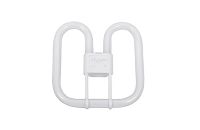
What are CFL bulbs?
A CFL bulb (compact fluorescent lamp) consists of a fluorescent coated glass tube filled with mercury vapour and gas. When electricity passes through the tube, invisible ultraviolet light is emitted, reacting with the fluorescent coating to produce visible white light.
CFL bulb pros:
- Energy-efficient: they use 60-80% less energy than traditional incandescent bulbs.
- Long lifespan: they can last up to 10 years.
- Money-saving: they are reasonably cheap to buy and pay for themselves quickly in energy savings.
- Quick to light: modern CFL bulbs light up to full brightness almost instantly when they’re turned on (old CFL bulbs were slow to light).
CFL bulb cons:
- Turning them on/off for short periods will shorten their life span: these bulbs should be left on or off for a minimum of 15 minutes to extend their life.
- Doesn’t work well in low temperatures: this makes them unsuitable for use in unheated rooms or outdoors.
- Hard to get some shapes and sizes: due to the global shift towards more energy-efficient LED bulbs, CFL bulbs may become harder to find over the coming years.
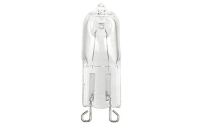
What are Halogen bulbs?
Halogen bulbs use an older type of technology than other bulbs. They consist of a glass-covered filament surrounded by halogen gas to produce light.
Halogen bulb pros:
- Quick to light: they light up to full brightness almost instantly when they’re turned on.
- Excellent colour rendering: they include all colours of the visible spectrum in their light, which means the colour across bulbs is more consistent than with other types of bulbs.
Halogen bulb cons:
- Not very energy efficient: they use 20-30% less energy than traditional incandescent bulbs. However, LED bulbs use 80% less energy than that. This means halogen bulbs cost significantly more to run than LED bulbs.
- Short life span: they last less than two years.
- They emit a lot of heat: they can get very hot, so care should be taken to avoid touching them while they are on.

What are Smart LED bulbs?
Smart light bulbs are LED light bulbs with in-built technology that allows them to be connected to and controlled by an app on a smartphone, tablet or speaker. Some connect to the smart device through WiFi, and some connect via Bluetooth. The user can turn the bulb on and off through the app or voice control and control schedules, brightness, and colour.
Read our Smart lighting guide to find out more.
Smart LED bulb pros:
- Very energy efficient: they're energy-efficient because they use LED technology, using up to 75% less energy than traditional incandescent bulbs.
- Very long lifespan: they can last 15-25 years.
- Money-saving: they're more expensive to buy, but they can pay for themselves in energy savings over their lifetime. And their smart functionality can help to reduce electricity usage. For example, lights can automatically be dimmed in the evening or can be combined with smart motion sensors, so lights are turned off when no one is in a room.
- Convenient: they can be controlled remotely through a smartphone or by voice command through a smart speaker. This is very convenient because the user doesn’t even have to leave their seat to dim the lights or switch them off.
- Added home security: WiFi-connected smart bulbs can be turned on remotely from anywhere. So, the user can turn the lights on in the evening to make it look like someone's home while they're away.
- Other smart technology integration: they can be connected to other smart home devices, such as smart security and motion sensors.
- Available for most light fittings: you can buy smart LED light bulbs for practically any type of light fitting.
- Quick to light: they light up to full brightness almost instantly when they’re turned on.
- Works in low temperatures: this makes them ideal for outdoor use, unlike some other bulb types.
Smart LED bulb cons:
-
Costs: buying a single bulb is a low-cost way to get started on smart lighting. But the initial cost to change all of a home’s bulbs to smart bulbs can be high.
Energy Efficiency of Light Bulbs
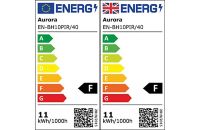
Modern light bulbs are more energy-efficient than old incandescent bulbs, especially LED bulbs. For example, LED bulbs use 90% less energy, CFL bulbs use 60-80% less energy, and halogen bulbs use 20-30% less energy than incandescent bulbs.
Modern light bulbs last longer too. Incandescent bulbs only last up to 1000 hours (approx. 6-9 months), while a halogen bulb lasts up to 2000 hours (approx. 1 year), a CFL bulb lasts up to 15,000 hours (approx. 10 years), and an LED bulb lasts up to 50,000 hours (approx. 25-30 years).
And when looking at the amount of energy they use per year in kilowatts, it's clear to see how their energy savings compare. For example, based on using 20 bulbs for 4 hours per day, in a year, incandescent bulbs would use 1752KW, halogen bulbs would use 1226KW, CFL bulbs would use 438KW and LED bulbs would use 292KW.
You can check how energy efficient a bulb is by looking at its energy label. Labels for appliances changed from March 2021, and light bulbs in September 2021, though. Old energy labels were rated from A++ to E. But, as most bulbs fell into the top rating, it was hard to differentiate between them. So, now the ratings go from A-G. Read our energy labels guide for more information.
Light Bulb Fitting Types
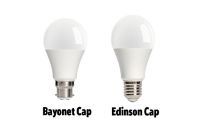
When referring to the fitting type of a light bulb, we’re talking about the size and type of the base – the part that connects to the lighting fixture. There are many light bulb fitting types available, and they are identified using a mix of numbers and letters, which we cover in more detail below.
What size base is a standard light bulb?
Standard light bulbs are the ones fitted in most homes in the primary overhead lights. There are two types of fitting for standard bulbs: bayonet cap and Edison screw.
The bayonet fitting uses a push and twist motion to lock it into the light fixture. The standard size used in most UK homes is 22mm in diameter, and it’s called a B22 or BC bulb.
The Edison screw simply screws into the light fixture. The standard size used in most UK homes is 27mm in diameter, and it’s called an E27 or ES bulb.
How to determine light bulb base size
Light bulb bases are identified by a code consisting of letters and numbers:
- The first letter or letters indicate the type of base (i.e., bayonet cap or Edison screw).
- The number indicates the diameter of the base or the distance between the pins (depending on the bulb type) in millimetres.
- If the light bulb is the type that has pins, there may be a third letter to indicate how many pins it has.
- There are some exceptions, with some bulbs being called for their bulb or their shape, rather than their cap width, such as G95 bulb.
Here are some examples of the most common bulb fitting types:
- B22 – a bayonet cap, 22mm in diameter. Used in standard overhead light fittings.
- B15 – a bayonet cap, 15mm in diameter. Mostly used in lamps.
- E27 – an Edison screw, 27mm in diameter. Used in standard overhead light fittings (also referred to as an ES).
- E14 – an Edison screw, 14mm in diameter. Mostly used in lamps (also referred to as an SES - small Edison screw).
- E12 – an Edison screw, 12mm in diameter. Used in candelabras (also referred to as a CES – candelabra Edison screw).
- E10 – an Edison screw, 10mm in diameter. Used in decorative lighting such as chandeliers (also referred to as an MES – miniature Edison screw).
- GU10 – a multi-pin (or bi-pin) with a universal ceramic base and two pins 10mm apart. Used in track-style spotlights and recessed lighting.
- G4 – a multi-pin (or bi-pin) base with two pins 4mm apart. This is a small and compact bulb used in decorative light fittings.
There are some exceptions to the coding rule. For example, an MR16 light bulb has a multifaceted reflector (MR) base with two pins. But the pins aren’t 16mm apart. Instead, the 16 stands for 16 eighths of an inch, which is 2” or 5cm. That’s the diameter of the bulb at its widest part. An MR bulb is used in spotlights designed for directional lighting.
Light Bulb Sizes and Shapes
Light bulbs come in many different sizes and shapes, but people generally buy light bulbs based on whether it fits their light fixture and it's a shape they like. So, does light bulb shape matter? Yes, it does because each shape provides a different spread and angle of light, affecting how the light is used and the room's ambience.
Also, consider the size and how the bulb will look in its light fitting. A large bulb protruding from the top of a lamp, for example, may look unsightly.
In the following few sections, we look at some of the more common light bulb shapes in more detail.

GLS or standard or traditional light bulbs
GLS is short for General Light Service. It’s a pear-shaped bulb that’s the most common and recognisable bulb shape available. This shape bulb spreads the light evenly, to almost 360°. It’s mostly used in overhead lighting, lamps and sconces (a type of wall light fixture).
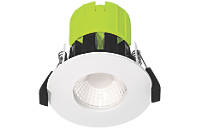
Downlight bulb types
A downlight is a bulb and light fitting combo designed to concentrate light in a downwards direction. Downlights can be recess mounted into a ceiling or used as task lights, for example, hung over a kitchen island.
These lights are known as reflector lights. This is because they contain many tiny reflector surfaces around the bulb that help focus and direct the beam. All reflector bulbs direct their beam downwards, but the spread of light will vary depending on the bulb. For example, a spot beam will have a narrow spread of up to 45°, whereas a flood beam will cover an area of around 120°.
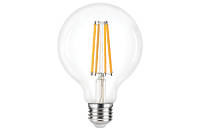
Globe shape light bulbs
Globe shaped light bulbs are large and round. Their attractive appearance makes them ideal for use in decorative light fittings. However, they may not suit smaller decorative fittings or enclosed lamps due to their size. This shape bulb spreads the light evenly, to almost 360°.
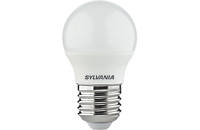
Golf ball light bulb
Golf ball-shaped light bulbs are also referred to as mini globe bulbs. They’re small and round, making them ideal for fixings and lamps with limited space. Because of their appealing design, they’re also often used in open fixtures without a shade. This shape bulb spreads the light evenly, to almost 360°.
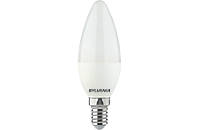
Candle light bulbs
Candle shaped light bulbs have a tapered design resembling a flame. Candle bulbs are commonly used in ornamental lighting, such as chandeliers or open fittings where the bulb is exposed. This shape bulb spreads the light evenly, to almost 360°.
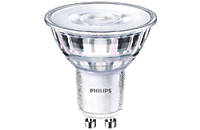
Spotlight bulbs
Spotlight shaped bulbs are also known as PAR bulbs (parabolic aluminised reflectors) because they use a reflective surface to focus the light beam (excludes LED spotlights). They are commonly used for kitchen and bathroom spotlighting, outdoor lighting, and floodlights. The beam spread of spotlights varies. For example, a narrow beam of 25° is standard for an indoor spotlight, whereas a beam spread of 60° or more is used for floodlights.
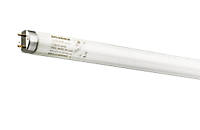
Other light bulb shapes
There are many other, less commonly used, light bulb shapes available. Such as tube light bulbs which are long, thin tubes commonly used in kitchens or picture lighting. And capsule light bulbs are tiny bulbs used in small fittings such as cooker hoods and cabinets.
You may also have seen spiral and stick-shaped bulbs, but these are no longer available.
Light Bulb Brightness
In the past, old incandescent bulbs displayed their brightness measured in watts. So, a 100W bulb would be brighter than a 60W bulb. But wattage is only a measure of the bulb’s power consumption, not brightness.
Modern, energy-saving bulbs use a lot less power to produce the same light. So, now brightness is measured in lumens (shown as lm). The higher the number of lumens, the brighter the light. The brightest light bulb can be 1525lm or more, while the dimmest is around 200lm.
Here’s an example of how this works:
To replace a 60W incandescent bulb in a living room, you'll need a 60 watt LED equivalent bulb of around 806lm, and its power will be 10W. Or, if the incandescent bulb is 100W, the equivalent LED bulb will be 1525lm and 18W.
What wattage bulb do I need?
The light bulb wattage you need will depend on where the bulb will be used and its purpose. If you simply want to replace an old incandescent bulb with an LED one, you may want to find the lumens equivalent for the wattage of the old bulb. If you are swapping a CFL or halogen bulb for an LED (or vice versa), the equivalent bulb will display the same number of lumens, but the wattage will be different.
Most light bulb product pages online includes information that tells you the old wattage equivalent next to their lumens number. So, if you want to shop the old way, you can. Alternatively, use the table in the next section to find equivalent bulbs for your needs.
Light Bulb Colour
All light bulbs produce slightly different colours, measured in Kelvin – a scale that indicates colour temperature. The Kelvin scale ranges from warm, soft, yellowy hues (2700K) to cool, bright, crisp whites (approx. 6500K). The higher the kelvin number (written as K), the whiter the light will be. The bulb colour will be referred to as colour temperature on the packaging and online, with its Kelvin measurement next to it. And some packaging also includes a colour description, such as warm white, cool white or daylight.
The light bulb colour you choose should depend on the type of lighting you want to achieve. For example, a warm white light of around 3500K is ideal for rooms where people want to relax and feel cosy, such as livings rooms and bedrooms. Whereas a crisp white light of about 6000K is more energising, so it's great for kitchens and bathrooms.
Colour-changing light bulbs which are smart remote-controlled to set the colour are also available.

Choosing the Best Light Bulb for the room
Finding the best light bulb for a room is really down to combining all the factors covered in this guide and matching it to the light fixture, the rooms use, and the desired ambience.
First, consider what light fixture the bulb needs to fit in. This will determine the fitting type of the bulb, but also its size and shape. Use decorative shapes for bulbs that will be visible and check the size fits the space.
Next, consider which room the light bulb is for? This will determine the bulb's brightness (lumens) and the colour temperature (Kelvin). We recommend a relaxing warm colour that's not too bright for living rooms and bedrooms. And for bathrooms, kitchens and home offices, try an energising crisp white, bright light.
There are some areas of the home where specialist light fittings, with specific light bulbs and casing should be used, for example, bathroom downlights. For main overhead lights, a standard bulb is fine.
5 Things to Consider Before Buying a Light Bulb
We've covered the most essential information you need to know before buying light bulbs in this guide. But here are five other things to consider:
1. What beam angle do I need?
Beam angles are relevant to any type of directional light bulb, i.e., bulbs designed for spotlights and downlighters. Beam angles are an important factor when buying these types of bulbs because they tell you how wide the light beam will spread. For example, a low beam angle of around 25° works well in small rooms when multiple lights are fitted close together. Whereas wider beam angles work better in larger rooms.
2. Do I need dimmable LED bulbs?
If you’d like to adjust the brightness of the lights in a room with a dimmer switch, then dimmable LED bulbs are recommended. But some old dimmer switches may not work with LED bulbs, and the bulb may flicker or buzz if they aren’t compatible. If that happens, you will need to upgrade the dimmer switch.
3. What about remote-controlled bulbs?
Remote control on bulbs is a convenient option that lets the user control one or more lights from a single place without getting up. Some bulbs come with a remote controller. But there are also smart light bulbs that connect to an app on a smartphone, tablet or smart speaker through WiFi. The bulb can be controlled through the app or by using voice commands.
4. How many spotlights do I need?
The number of spotlights needed for a room depends on the room’s size. As a guide, you will need one spotlight for every 1m2. Place spotlights approximately 0.5m away from the walls and leave a gap of 1m between each light.
5. What are the best light bulbs for the bedroom?
The best light bulb for a bedroom has a colour temperature of around 800 lumens. This gives out a warm, soft yellow light. It will be bright enough to read by but not bright enough to disturb sleep.

